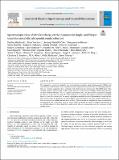Spectroscopic view of ultrafast charge carrier dynamics in single- and bilayer transition metal dichalcogenide semiconductors
Abstract
The quasiparticle spectra of atomically thin semiconducting transition metal dichalcogenides (TMDCs) and their response to an ultrafast optical excitation critically depend on interactions with the underlying substrate. Here, we present a comparative time- and angle-resolved photoemission spectroscopy (TR-ARPES) study of the transient electronic structure and ultrafast carrier dynamics in the single- and bilayer TMDCs MoS2 and WS2 on three different substrates: Au(111), Ag(111) and graphene/SiC. The photoexcited quasiparticle bandgaps are observed to vary over the range of 1.9-2.3 eV between our systems. The transient conduction band signals decay on a sub-100 fs timescale on the metals, signifying an efficient removal of photoinduced carriers into the bulk metallic states. On graphene, we instead observe two timescales on the order of 200 fs and 50 ps, respectively, for the conduction band decay in MoS2. These multiple timescales are explained by Auger recombination involving MoS2 and in-gap defect states. In bilayer TMDCs on metals we observe a complex redistribution of excited holes along the valence band that is substantially affected by interactions with the continuum of bulk metallic states.
Citation
Majchrzak , P , Volckaert , K , Cabo , A G , Biswas , D , Bianchi , M , Mahatha , S K , Dendzik , M , Andreatta , F , Grønborg , S S , Marković , I , Riley , J M , Johannsen , J C , Lizzit , D , Bignardi , L , Lizzit , S , Cacho , C , Alexander , O , Matselyukh , D , Wyatt , A S , Chapman , R T , Springate , E , Lauritsen , J V , King , P D C , Sanders , C E , Miwa , J A , Hofmann , P & Ulstrup , S 2021 , ' Spectroscopic view of ultrafast charge carrier dynamics in single- and bilayer transition metal dichalcogenide semiconductors ' , Journal of Electron Spectroscopy and Related Phenomena , vol. 250 , 147093 . https://doi.org/10.1016/j.elspec.2021.147093
Publication
Journal of Electron Spectroscopy and Related Phenomena
Status
Peer reviewed
ISSN
0368-2048Type
Journal article
Description
Funding: We gratefully acknowledge funding from VILLUM FONDEN through the Young Investigator Program (Grant. No. 15375) and the Centre of Excellence for Dirac Materials (Grant.No. 11744), the Danish Council for Independent Research, Natural Sciences under the Sapere Aude program (Grant Nos. DFF-9064-00057B and DFF-6108-00409). Access to the Artemis Facility was funded by STFC. I.M. acknowledges financial support by the International Max Planck Research School for Chemistry and Physics of Quantum Materials (IMPRS-CPQM). The authors also acknowledge The Royal Society and The Leverhulme Trust.Collections
Items in the St Andrews Research Repository are protected by copyright, with all rights reserved, unless otherwise indicated.

